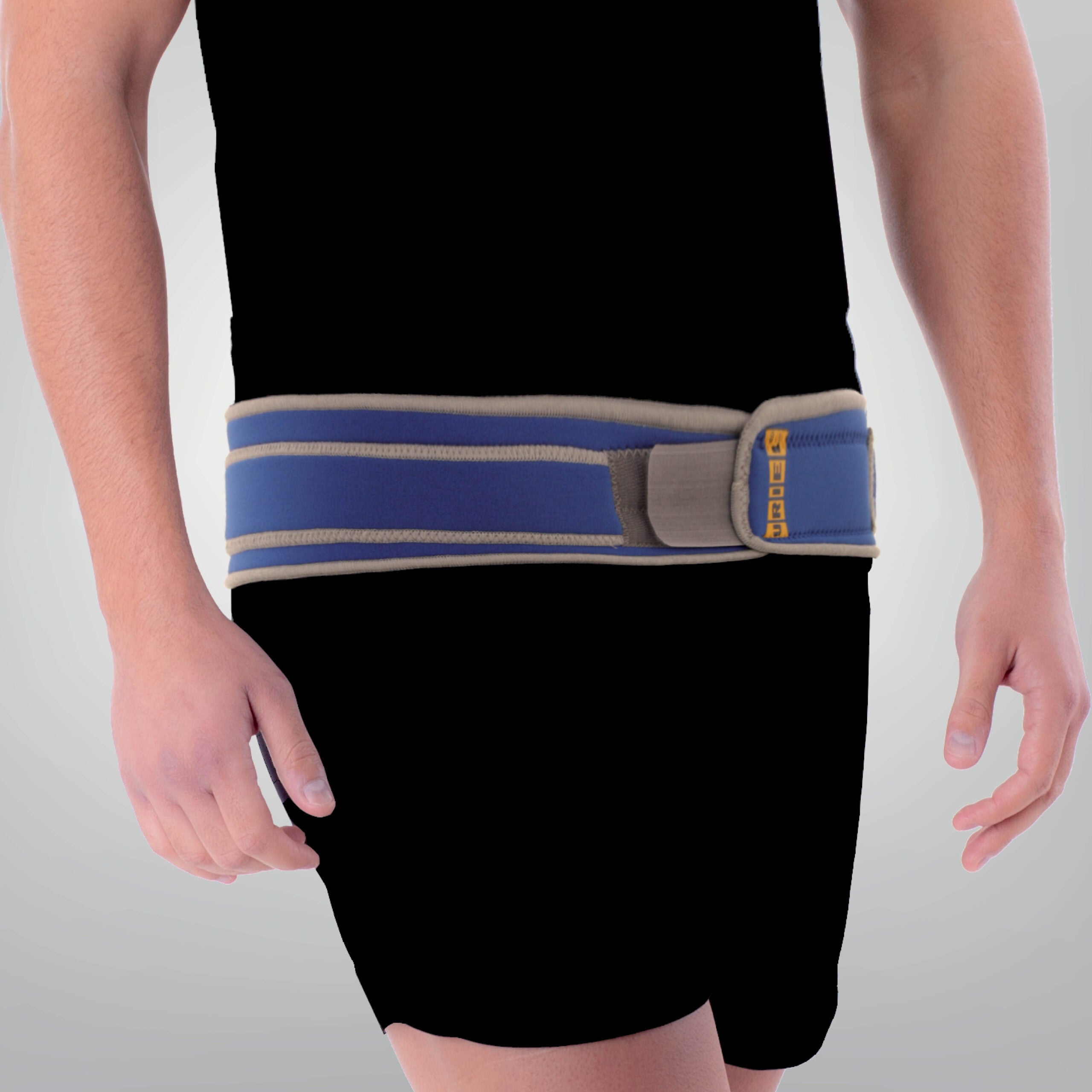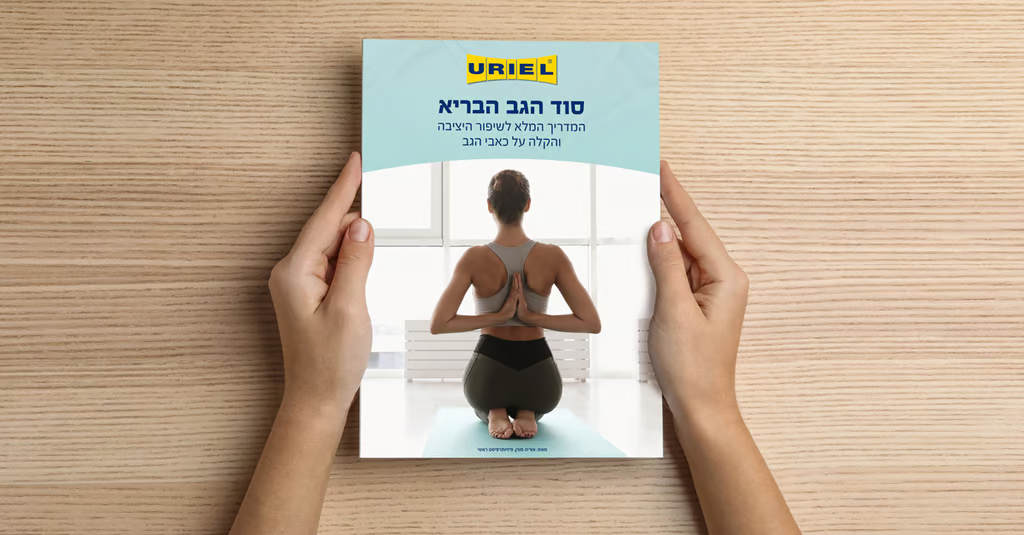
Sacro belt | T03
Pelvic belt for joint support and pain relief
Designed to relieve pain resulting from poor movement in the pelvic bones. The belt provides support for the sacro-iliac joints and improves stability in conditions such as pregnancy pain, pelvic girdle dysfunction, and herniated discs. The belt is worn around the pelvis for comfort and targeted support.
Medical indications:
- Lower back pain - mainly resulting from overexertion or pelvic instability.
- Pelvic pain - including conditions such as symphysiolysis or pelvic bone pain after injury.
- Sacro-Iliac Dysfunction
- Pregnancy and postpartum pain - for pelvic support and reducing strain during and after pregnancy.
- Piriformis syndrome - to relieve pressure from the sciatic nerve through pelvic stabilization.
- Osteoarthritis pain - in the pelvic joints.
- Support after orthopedic surgeries - in cases of rehabilitation related to the pelvis or lower back.

Dimensions

Extended description
User manual
- The belt is designed to be worn around the lower pelvic area, not the waist area.
- Make sure the belt is positioned below the anterior pelvic iliac crests (ASIS).
- Tighten the belt so that it is snug but not too tight.
- The belt can be worn during daily activities such as walking, standing, sitting, and light physical work.
- It is recommended to remove the belt during prolonged rest (such as sleeping), unless otherwise recommended by a professional.
- Start with a few hours of use a day and gradually increase according to comfort and need.
- In case of pain or discomfort, remove the belt and consult a physiotherapist or doctor.
- If you are unsure how to adjust the belt correctly, contact a professional for guidance.
- After use, the belt should be aired to prevent wear and tear and maintain its quality over time.
- The use of the belt does not replace medical or physical therapy, and should be incorporated as part of a personalized treatment plan.
Our expert advice
A pelvic belt is an effective tool for support and stabilization, but to maximize its benefits and integrate it into your daily routine correctly, here are some important tips:
Use in combination with exercise:
- It is important to combine the use of the belt with moderate physical activity to improve the stability and strength of the pelvic and pelvic floor muscles.
- Recommended activities: walking, Pilates, adapted yoga, or water exercises.
- Use a belt during activity, especially if you experience pain or a feeling of instability in your pelvis.
Recommendation for basic exercises:
Pelvic floor muscle contractions:
- Sit comfortably or lie on your back.
- Gently contract the muscles used to hold urine.
- Hold for 5 seconds and release. Repeat 10 times.
Pelvic bridge exercises:
- Lie on your back with your knees bent and feet flat on the floor.
- Lift your pelvis up until your body forms a straight line between your knees and shoulders.
- Hold for 5-10 seconds and release. Repeat 8-12 times.
Back and hip stretch (cat-cow):
- Get on all fours (hands and knees).
- Bend your back upwards and lower your head down, then make a gentle arch in your back and lift your head.
- Repeat the movement 10-15 times at a slow pace.
Listen to your body:
If you feel increased pressure or pain while using the belt or performing exercises, stop the activity and consult a physical therapist. Remember: the belt is designed to support, not cause discomfort.
Rest and proper maintenance:
It is not necessary to use the belt during rest hours or while sleeping, unless otherwise recommended.
Combining a healthy diet and routine:
- Maintain a balanced diet and adequate hydration, as good overall health also affects muscle function.
- Try to avoid standing or sitting for long periods of time without changing position.
- If you sit for long periods of time, get up every half hour for a short walk or stretch.
Personal consultation:
If you are using a belt as a result of a medical problem such as pregnancy pain, pelvic joint dysfunction, or injury, it is recommended that you get a personalized program from a physical therapist. Combined treatment that includes muscle strengthening, stretching, and proper use of the belt will yield the best results.
Using a pelvic belt is part of a rehabilitation or support process. To achieve optimal results, it is important to be consistent and use it as part of an overall program to improve the stability and health of the pelvic area.

- The belt is designed to be worn around the lower pelvic area, not the waist area.
- Make sure the belt is positioned below the anterior pelvic iliac crests (ASIS).
- Tighten the belt so that it is snug but not too tight.
- The belt can be worn during daily activities such as walking, standing, sitting, and light physical work.
- It is recommended to remove the belt during prolonged rest (such as sleeping), unless otherwise recommended by a professional.
- Start with a few hours of use a day and gradually increase according to comfort and need.
- In case of pain or discomfort, remove the belt and consult a physiotherapist or doctor.
- If you are unsure how to adjust the belt correctly, contact a professional for guidance.
- After use, the belt should be aired to prevent wear and tear and maintain its quality over time.
- The use of the belt does not replace medical or physical therapy, and should be incorporated as part of a personalized treatment plan.
A pelvic belt is an effective tool for support and stabilization, but to maximize its benefits and integrate it into your daily routine correctly, here are some important tips:
Use in combination with exercise:
- It is important to combine the use of the belt with moderate physical activity to improve the stability and strength of the pelvic and pelvic floor muscles.
- Recommended activities: walking, Pilates, adapted yoga, or water exercises.
- Use a belt during activity, especially if you experience pain or a feeling of instability in your pelvis.
Recommendation for basic exercises:
Pelvic floor muscle contractions:
- Sit comfortably or lie on your back.
- Gently contract the muscles used to hold urine.
- Hold for 5 seconds and release. Repeat 10 times.
Pelvic bridge exercises:
- Lie on your back with your knees bent and feet flat on the floor.
- Lift your pelvis up until your body forms a straight line between your knees and shoulders.
- Hold for 5-10 seconds and release. Repeat 8-12 times.
Back and hip stretch (cat-cow):
- Get on all fours (hands and knees).
- Bend your back upwards and lower your head down, then make a gentle arch in your back and lift your head.
- Repeat the movement 10-15 times at a slow pace.
Listen to your body:
If you feel increased pressure or pain while using the belt or performing exercises, stop the activity and consult a physical therapist. Remember: the belt is designed to support, not cause discomfort.
Rest and proper maintenance:
It is not necessary to use the belt during rest hours or while sleeping, unless otherwise recommended.
Combining a healthy diet and routine:
- Maintain a balanced diet and adequate hydration, as good overall health also affects muscle function.
- Try to avoid standing or sitting for long periods of time without changing position.
- If you sit for long periods of time, get up every half hour for a short walk or stretch.
Personal consultation:
If you are using a belt as a result of a medical problem such as pregnancy pain, pelvic joint dysfunction, or injury, it is recommended that you get a personalized program from a physical therapist. Combined treatment that includes muscle strengthening, stretching, and proper use of the belt will yield the best results.
Using a pelvic belt is part of a rehabilitation or support process. To achieve optimal results, it is important to be consistent and use it as part of an overall program to improve the stability and health of the pelvic area.
Blog

Treating Lower Back Pain: 6 Tips to Improve Quality of Life
Suffering from lower back pain? You are definitely not alone. There are many ways to deal with one of the most common pains in the world, here are some of them. It's time to relieve the pain.

The Secret to a Healthy Back: The Complete Guide to Improving Posture and Alleviating Back Pain
Is back health important to you? Get the 'Secret of a Healthy Back' guide containing information, tips and useful advice for relieving back pain. By Oriya Moran, Chief Physiotherapist Download t...

Kinesio tape or professional elastic bandage?
Suffering from sports injuries, bruises or simply pain caused by medical problems? Get to know the variety of dressing products that will support you. When should we use kinesiology tape and why d...
